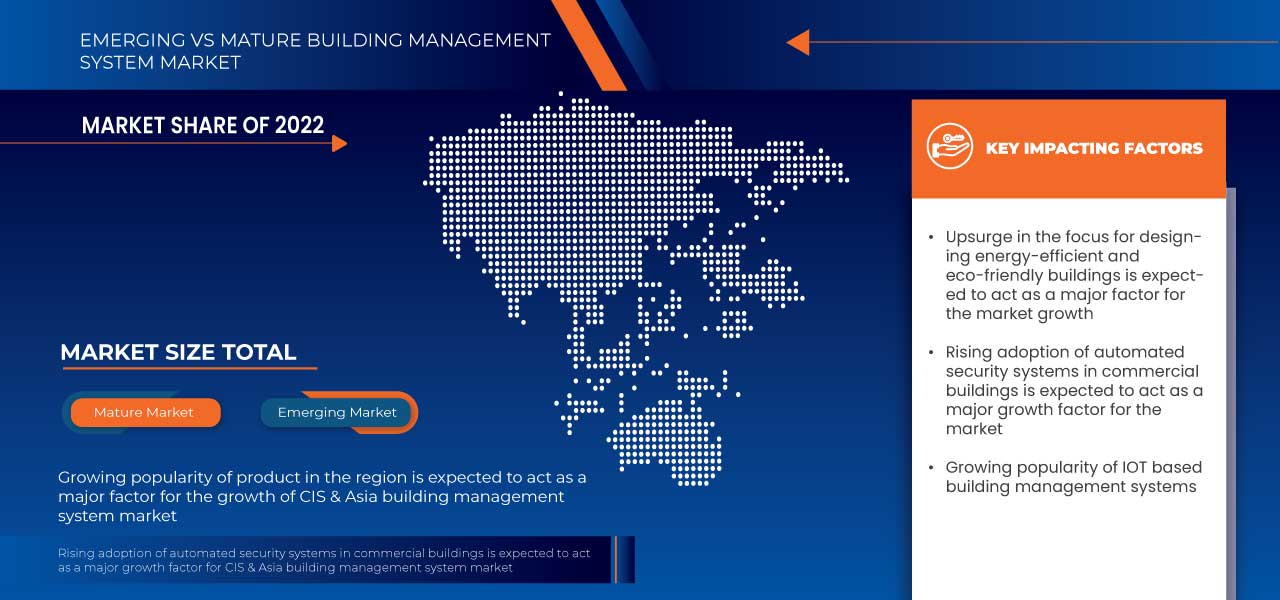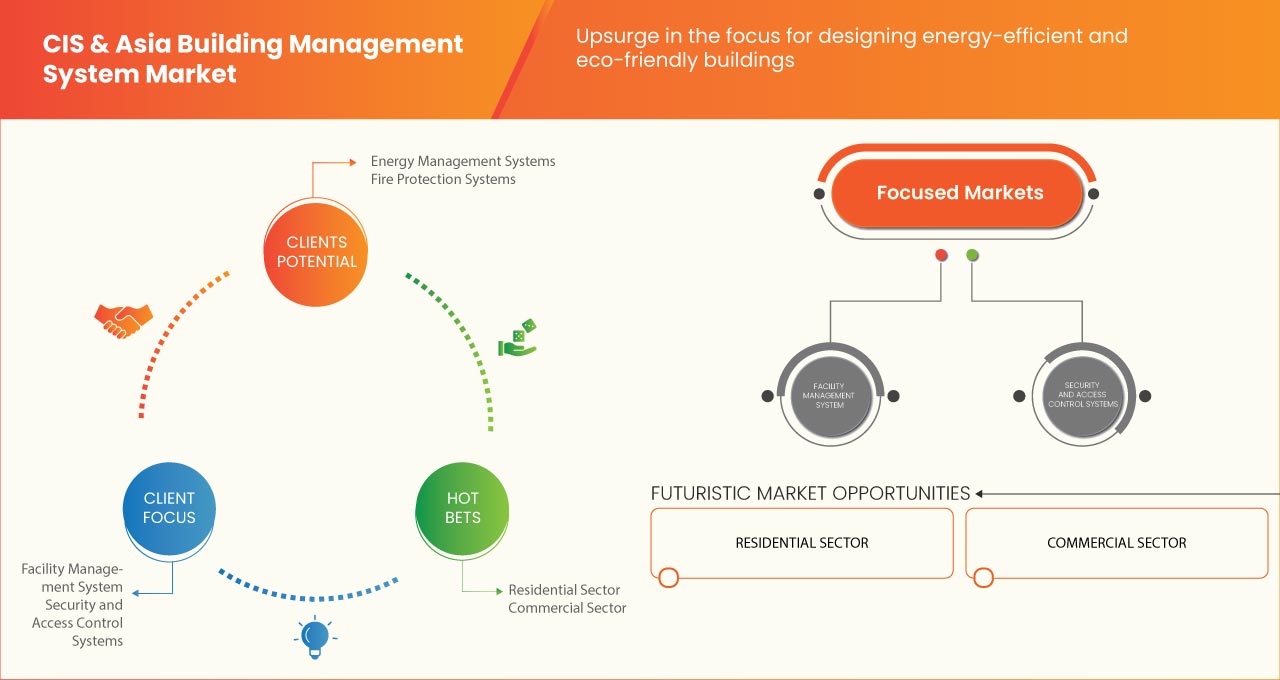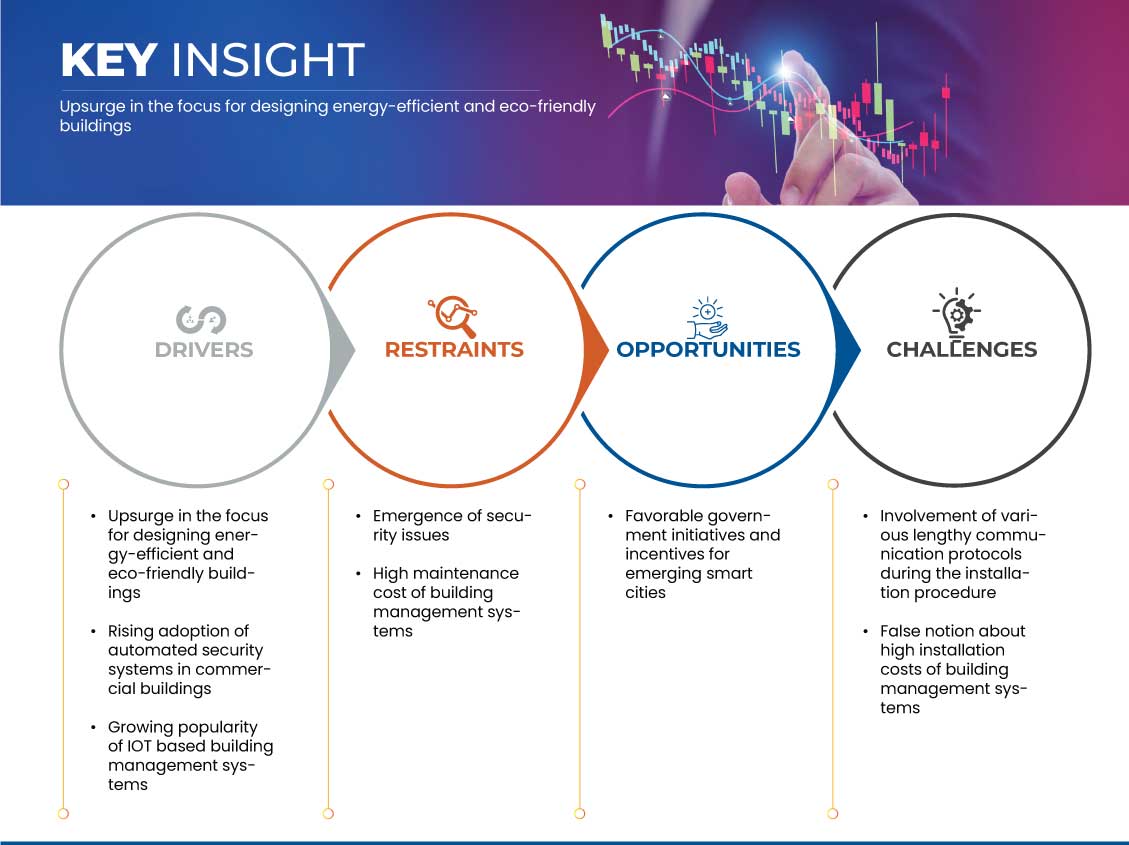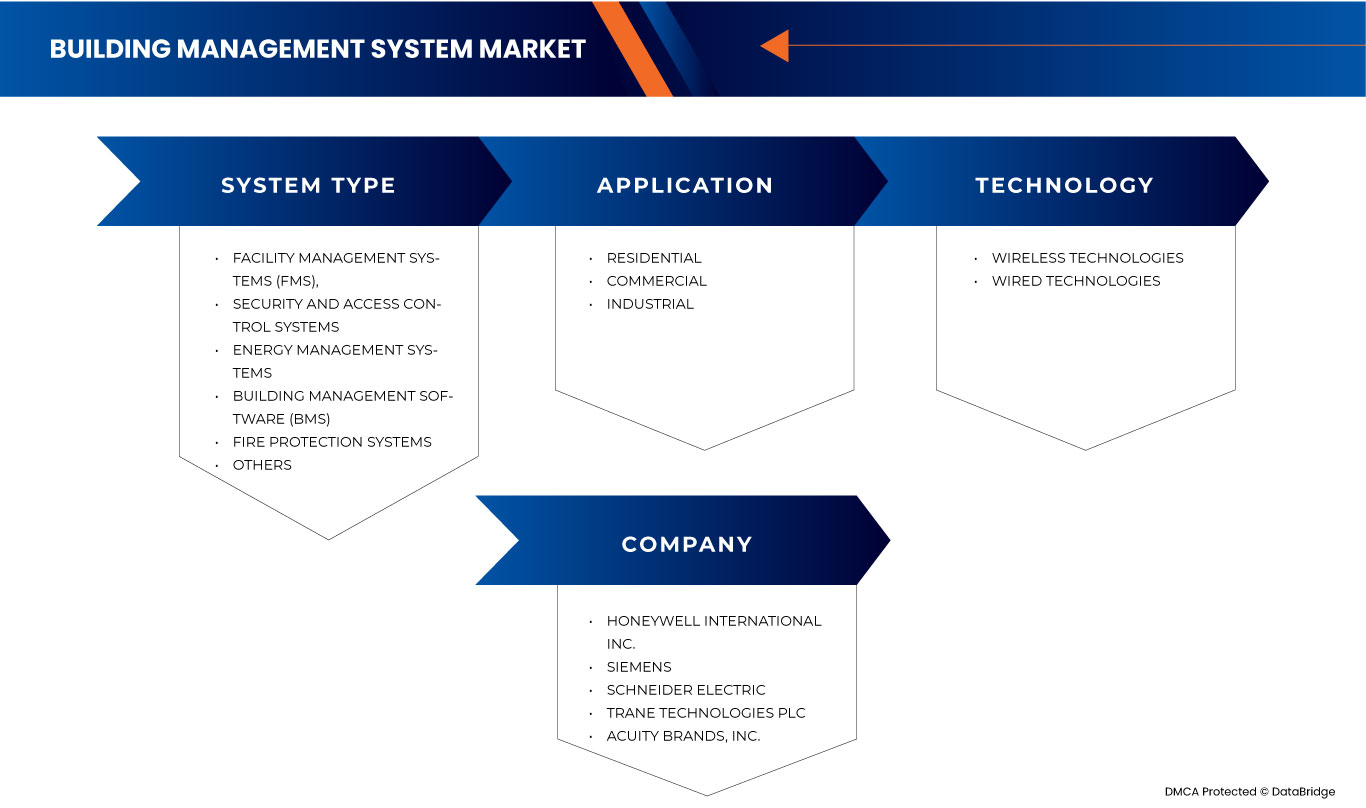Cis And Asia Building Management System Market
Market Size in USD Thousand
CAGR :
% 
 USD
18,600,033.21 Thousand
USD
27,366,169.09 Thousand
2022
2030
USD
18,600,033.21 Thousand
USD
27,366,169.09 Thousand
2022
2030
| 2023 –2030 | |
| USD 18,600,033.21 Thousand | |
| USD 27,366,169.09 Thousand | |
|
|
|
CIS & Asia Building Management System Market, By System Type (Facility Management Systems (FMS), Security and Access Control Systems, Energy Management Systems, Building Management Software (BMS), Fire Protection Systems, and Others), Technology (Wireless Technologies, Wired Technologies), Application (Residential, Commercial, and Industrial) - Industry Trends and Forecast to 2030.
CIS and Asia Building Management System Market Analysis and Size
The CIS & Asia building management system market is being driven by the upsurge in the focus on designing energy-efficient and eco-friendly buildings. In addition, the rising adoption of automated security systems in commercial buildings is likely to fuel the market's growth. Additionally, the favorable government initiatives and incentives for emerging smart cities will open up more business potential for the building management system market in the forecast period 2023-2030.
Data Bridge Market Research analyzes that the CIS & Asia building management system market is expected to reach USD 27,366,169.09 thousand by 2030 from USD 18,600,033.21 thousand in 2022, growing with a substantial CAGR of 5.1% in the forecast period of 2023 to 2030. The rising adoption of automated security systems in commercial buildings contributes to market growth.
|
Report Metric |
Details |
|
Forecast Period |
2023 to 2030 |
|
Base Year |
2022 |
|
Historic Year |
2021 (Customizable 2015 to 2020) |
|
Quantitative Units |
Revenue in USD Thousand |
|
Segments Covered |
System Type (Facility Management Systems (FMS), Security and Access Control Systems, Energy Management Systems, Building Management Software (BMS), Fire Protection Systems, and Others), Technology (Wireless Technologies, Wired Technologies), Application (Residential, Commercial, and Industrial) |
|
Countries Covered |
China, Japan, South Korea, Singapore, India, Malaysia, Thailand, Philippines, Indonesia, Rest of Asia, Russia, Ukraine, Kazakhstan, Belarus, Kyrgyzstan, Georgia, Moldova, Rest of CIS |
|
Market Players Covered |
Honeywell International Inc. (U.S.), Siemens (Germany), Schneider Electric (France), Trane Technologies plc (Ireland), ACUITY BRANDS, INC. (U.S.), Axonator Inc (U.S.), Beckhoff Automation (Germany), Johnson Controls (U.S.), Convergint Technologies LLC (U.S.), Crestron Electronics (U.S.), Robert Bosch GmbH (Germany), Bajaj Electricals Ltd (India), Delta Electronics, Inc (Taiwan), and Hitachi, Ltd (Japan) among others |
Market Definition
The building management systems market refers to the industry focused on providing comprehensive computer-operated and automated control solutions for managing and monitoring various mechanical and electrical systems within buildings. These systems include ventilation, lighting, electricity, fire extinguishing, and security systems. The market caters to diverse facilities such as commercial offices, retail stores, hotels, manufacturing plants, warehouses, and residential buildings. Building management systems play a crucial role in ensuring the efficient and effective operation of modern structures by optimizing energy usage, enhancing occupant comfort, and streamlining maintenance processes. The increasing trend towards smart buildings and the growing demand for energy-efficient solutions contribute to the continuous expansion and innovation in the building management systems market.
CIS & Asia Building Management System Market Dynamics
This section deals with understanding the market drivers, advantages, opportunities, restraints, and challenges. All of this is discussed in detail as below:
DRIVERS:
- Upsurge in the focus on designing energy-efficient and eco-friendly buildings
Energy conservation through energy efficiency in the building has acquired major importance worldwide. The main aspects of energy efficiency in a building include energy-passive building design before actual construction and the usage of low-energy building materials during construction. The main focus of green building construction is the integration of renewable energy technologies and the use of efficient equipment with low operational energy requirements.
Energy consumption in buildings and infrastructure is increasing exponentially, suggesting the need to develop alternatives to save energy and sustainably operate buildings. Energy efficiency can be achieved with insulation, improved building techniques, and modified construction methods for buildings, which raises the demand for sustainable management systems for buildings.
Power demand to operate buildings must be reduced to develop energy-efficient and sustainable buildings for the future. Besides, designing an energy-efficient building involves constructing or upgrading a building that can do most of the work by providing the right energy supply. Energy-efficient homes are less expensive to operate, more comfortable to live in, and more environmentally friendly, whether they have been refurbished in an energy-efficient manner or built to be energy efficient.
Furthermore, the growing awareness of consumers regarding energy-efficient building design during any new construction is effective to make homes more efficient and is also less expensive for a homeowner in the long run. This, as a result, increases the demand for building management systems and thus contributes to the growth of the CIS & Asia building management system market.
- Rising adoption of automated security systems in commercial buildings
Security systems are essential for all buildings, especially for commercial buildings. It assures the consistency of business operations and the security of physical and intellectual property. Commercial properties such as industrial enterprises, financial and governmental institutions, schools, medical facilities, and oil and gas companies require a unique set of safety and security measures as each type of property is vulnerable to different hazards.
A security system for commercial buildings presents a more comprehensive solution than typical apartment building security systems and comprises different management systems. This includes multi-layered commercial access control, various sensors, and detectors, such as infrared, microwave, or laser sensors, and perimeter security (CCTV), among others. All commercial security systems can be integrated into a complex security solution with greater flexibility and scalability.
In addition, many commercial building managers rely on security guards to keep their buildings safe. However, human guards cannot be everywhere at once, and that is why it is best to have a security automation system to protect the property. The building security systems provide a safe and efficient way to blanket the property with complete monitoring surveillance. Security automation also archives all activities on the premises to address building vulnerabilities, blind spots, dark areas, and other security issues.
Furthermore, automatic security systems for commercial buildings provide a viable solution to security issues with elevator and building access control options, comprehensive camera and recording security devices, thermal imaging solutions, and thus accelerating the growth of the CIS & Asia building management system market.
Restraint/Challenge
Emergence of security issues
In recent years, many buildings have been installed with two-way communication systems for advanced monitoring and controlling resources from the data center, which fosters the need for building management systems. Therefore, the spread of building management systems has also increased the prevalence of cyberattacks on companies, government institutions, and other newly built buildings, due to which genuine concerns are likely to emerge on the security systems of the buildings.
Malicious software can penetrate a building system through unsecured networks and cause disruptions. Technical issues and other viral threats can often lead to loss of communication and access to sensitive data, affecting the operation of devices such as video surveillance in buildings. In addition, cyberattacks compromise the security and firewalls of the building and other systems that connect it.
The integration of cloud, data analytics, and IoT also provides a wide range of platforms for innovation that can translate a humongous energy-consuming giant to run an enterprise efficiently. However, with the increased data connectivity nodes and huge data generation comes the risk of cybersecurity threats. The occurrence of technological issues in terms of proper internet connections and operations of the smart devices may also create several problems in the smooth functioning of the building management systems.
Moreover, when a building connects all the devices in the system to a single control network, there is a risk that a malicious user or outsider could effectively hack into the building, decreases the demand for building management systems and is likely to hinder the growth of the CIS & Asia building management system market.
Opportunity
- Favorable government initiatives and incentives for emerging smart cities
Smart buildings include advanced building management system that improves the way governments monitor and control machinery, heating, cooling, and lighting systems in federal buildings across the countries, increasing the efficiency of these systems. Building management system technology collects raw data from mechanical or electrical systems, analyses it, and uses the results to identify inefficiencies that can be corrected immediately.
The smart buildings initiative allows governments to make a real difference by implementing innovative technologies and identifying opportunities to save energy. The government is stepping up efforts to improve energy performance management in federal buildings through the smart buildings initiative. This will lead to a reduction in environmental footprint and energy costs by implementing intelligent building management systems.
Energy efficiency involves efficient utilization of energy resources which promotes sustainable development. Against the backdrop of growing economies and concurrent income growth, the real estate sector of various emerging economies such as India, Japan, and Brazil has undergone a drastic transformation in the past few years. The government policies have been at the crux, providing vital stimulus for the industry's growth and encouraging small and medium stakeholders to invest in the real estate sector.
Furthermore, through the smart building initiative, the government of every country is improving the energy performance management of federal buildings which results in lower greenhouse gas emissions and reduced energy costs. Thus, it is projected to create a significant opportunity for the growth of the CIS & Asia building management system market.
CIS & Asia Building Management System Market Scope
The CIS & Asia building management system market is segmented into three notable segments based on system type, technology, and application. The growth amongst these segments will help you analyze major growth segments in the industries and provide the users with a valuable market overview and market insights to help them make strategic decisions for identifying core market applications.
System Type
- Facility Management Systems (FMS)
- Security and Access Control Systems
- Energy Management Systems
- Building Management Software (BMS)
- Fire Protection Systems
- Others
On the basis of system type, the market is segmented into facility management systems (FMS), security and access control systems, energy management systems, building management software (BMS), fire protection systems, and others.
Technology
- Wireless Technologies
- Wired Technologies
On the basis of technology, the market is segmented into wireless technologies and wired technologies.
Application
- Residential
- Commercial
- Industrial
On the basis of application, the market is segmented into residential, commercial, and industrial.
CIS and Asia Building Management System Market Regional Analysis/Insights
The CIS & Asia building management system market is analyzed and market size insights and trends are provided by country, system type, technology, and application as referenced above.
The countries covered in the CIS & Asia building management system market report are China, Japan, South Korea, Singapore, India, Malaysia, Thailand, Philippines, Indonesia, Rest of Asia, Russia, Ukraine, Kazakhstan, Belarus, Kyrgyzstan, Georgia, Moldova, and Rest of CIS.
Asia is dominating and is expected to show the highest growth in the forecast period due to the rising adoption of automated security systems in commercial buildings. Commercial companies require a unique set of safety and security measures as each type of property is vulnerable to different hazards.
The country section of the report also provides individual market impacting factors and changes in market regulation that impact the current and future trends of the market. Data points like down-stream and upstream value chain analysis, technical trends, and porter's five forces analysis, case studies are some of the pointers used to forecast the market scenario for individual countries. Also, the presence and availability of brands and their challenges faced due to large or scarce competition from local and domestic brands, the impact of domestic tariffs, and trade routes are considered while providing forecast analysis of the country data.
Competitive Landscape and CIS & Asia Building Management System Market Share Analysis
The CIS & Asia building management system market competitive landscape provides details by competitor. Details included are company overview, company financials, revenue generated, market potential, investment in research and development, new market initiatives, global presence, production sites and facilities, production capacities, company strengths and weaknesses, product launch, product width and breadth, application dominance. The above data points provided are only related to the companies' focus on the CIS & Asia building management system market.
Some of the major players operating in the CIS & Asia building management system market are Honeywell International Inc., Siemens, Schneider Electric, Trane Technologies plc, ACUITY BRANDS, INC., Axonator Inc, Beckhoff Automation, Johnson Controls, Convergint Technologies LLC, Crestron Electronics, Robert Bosch GmbH, Bajaj Electricals Ltd, Delta Electronics, Inc, and Hitachi, Ltd., among others.
SKU-
Get online access to the report on the World's First Market Intelligence Cloud
- Interactive Data Analysis Dashboard
- Company Analysis Dashboard for high growth potential opportunities
- Research Analyst Access for customization & queries
- Competitor Analysis with Interactive dashboard
- Latest News, Updates & Trend analysis
- Harness the Power of Benchmark Analysis for Comprehensive Competitor Tracking
Table of Content
1 INTRODUCTION
1.1 OBJECTIVES OF THE STUDY
1.2 MARKET DEFINITION
1.3 OVERVIEW
1.4 LIMITATIONS
1.5 MARKETS COVERED
2 MARKET SEGMENTATION
2.1 MARKETS COVERED
2.2 GEOGRAPHICAL SCOPE
2.3 YEARS CONSIDERED FOR THE STUDY
2.4 CURRENCY AND PRICING
2.5 DBMR TRIPOD DATA VALIDATION MODEL
2.6 MULTIVARIATE MODELING
2.7 PRIMARY INTERVIEWS WITH KEY OPINION LEADERS
2.8 DBMR MARKET POSITION GRID
2.9 MARKET APPLICATION COVERAGE GRID
2.1 DBMR VENDOR SHARE ANALYSIS
2.11 SECONDARY SOURCES
2.12 ASSUMPTIONS
3 EXECUTIVE SUMMARY
4 PREMIUM INSIGHTS
4.1 PORTER’S FIVE FORCES:
4.1.1 THREAT OF NEW ENTRANTS:
4.1.2 THREAT OF SUBSTITUTES:
4.1.3 CUSTOMER BARGAINING POWER:
4.1.4 SUPPLIER BARGAINING POWER:
4.1.5 INTERNAL COMPETITION (RIVALRY):
4.2 BUILDING MANAGEMENT SYSTEM REGULATIONS
4.2.1 THE NATIONAL BUILDING CODE OF INDIA (NBC)
4.2.2 INTERNATIONAL ORGANIZATION FOR STANDARDIZATION
4.3 GOVERNMENT REGULATION - FAIR AND TRANSPARENT USE OF BIOMETRIC SYSTEM-POWERED ACCESS CONTROL
4.3.1 ISO/IEC 2382-37
4.3.2 ISO/IEC JOINT TECHNICAL COMMITTEE 1
5 MARKET OVERVIEW
5.1 DRIVERS
5.1.1 UPSURGE IN THE FOCUS FOR DESIGNING ENERGY-EFFICIENT AND ECO-FRIENDLY BUILDINGS
5.1.2 RISING ADOPTION OF AUTOMATED SECURITY SYSTEMS IN COMMERCIAL BUILDINGS
5.1.3 GROWING POPULARITY OF IOT BASED BUILDING MANAGEMENT SYSTEMS
5.2 RESTRAINTS
5.2.1 EMERGENCE OF SECURITY ISSUES
5.2.2 HIGH MAINTENANCE COST OF BUILDING MANAGEMENT SYSTEMS
5.3 OPPORTUNITIES
5.3.1 FAVOURABLE GOVERNMENT INITIATIVES AND INCENTIVES FOR EMERGING SMART CITIES
5.4 CHALLENGES
5.4.1 INVOLVEMENT OF VARIOUS LENGTHY COMMUNICATION PROTOCOLS DURING THE INSTALLATION PROCEDURE
5.4.2 FALSE NOTION ABOUT HIGH INSTALLATION COSTS OF BUILDING MANAGEMENT SYSTEMS
6 COMPANY SHARE ANALYSIS: CIS & ASIA
6.1 LAUNCH OF BUILDING AUTOMATION
6.2 AWARD
6.3 ACQUISITION
6.4 PARTNERSHIP
7 COMPANY PROFILES
7.1 SCHNEIDER ELECTRIC
7.1.1 COMPANY SNAPSHOT
7.1.2 REVENUE ANALYSIS
7.1.3 PRODUCT PORTFOLIO
7.1.4 RECENT DEVELOPMENTS
7.2 JOHNSON CONTROLS
7.2.1 COMPANY SNAPSHOT
7.2.2 REVENUE ANALYSIS
7.2.3 PRODUCT PORTFOLIO
7.2.4 RECENT DEVELOPMENTS
7.3 SIEMENS
7.3.1 COMPANY SNAPSHOT
7.3.2 REVENUE ANALYSIS
7.3.3 PRODUCT PORTFOLIO
7.3.4 RECENT DEVELOPMENTS
7.4 HONEYWELL INTERNATIONAL INC.
7.4.1 COMPANY SNAPSHOT
7.4.2 REVENUE ANALYSIS
7.4.3 PRODUCT PORTFOLIO
7.4.4 RECENT DEVELOPMENTS
7.5 TRANE TECHNOLOGIES PLC
7.5.1 COMPANY SNAPSHOT
7.5.2 REVENUE ANALYSIS
7.5.3 PRODUCT PORTFOLIO
7.5.4 RECENT DEVELOPMENT
7.6 ACUITY BRANDS, INC.
7.6.1 COMPANY SNAPSHOT
7.6.2 REVENUE ANALYSIS
7.6.3 PRODUCT PORTFOLIO
7.6.4 RECENT DEVELOPMENTS
7.7 AXONATOR INC
7.7.1 COMPANY SNAPSHOT
7.7.2 PRODUCT PORTFOLIO
7.7.3 RECENT DEVELOPMENT
7.8 BAJAJ ELECTRICALS LTD
7.8.1 COMPANY SNAPSHOT
7.8.2 REVENUE ANALYSIS
7.8.3 PRODUCT PORTFOLIO
7.8.4 RECENT DEVELOPMENT
7.9 BECKHOFF AUTOMATION
7.9.1 COMPANY SNAPSHOT
7.9.2 PRODUCT PORTFOLIO
7.9.3 RECENT DEVELOPMENT
7.1 CONVERGINT TECHNOLOGIES LLC
7.10.1 COMPANY SNAPSHOT
7.10.2 PRODUCT PORTFOLIO
7.10.3 RECENT DEVELOPMENTS
7.11 CRESTON ELECTRONICS
7.11.1 COMPANY SNAPSHOT
7.11.2 PRODUCT PORTFOLIO
7.11.3 RECENT DEVELOPMENT
7.12 DELTA ELECTRONICS, INC
7.12.1 COMPANY SNAPSHOT
7.12.2 REVENUE ANALYSIS
7.12.3 PRODUCT PORTFOLIO
7.12.4 RECENT DEVELOPMENT
7.13 HITACHI, LTD.
7.13.1 COMPANY SNAPSHOT
7.13.2 REVENUE ANALYSIS
7.13.3 PRODUCT PORTFOLIO
7.13.4 RECENT DEVELOPMENTS
7.14 ROBERT BOSCH GMBH
7.14.1 COMPANY SNAPSHOT
7.14.2 REVENUE ANALYSIS
7.14.3 PRODUCT PORTFOLIO
7.14.4 RECENT DEVELOPMENTS
8 QUESTIONNAIRE
9 RELATED REPORTS
List of Figure
FIGURE 1 CIS & ASIA BUILDING MANAGEMENT SYSTEM MARKET: SEGMENTATION
FIGURE 2 CIS & ASIA BUILDING MANAGEMENT SYSTEM MARKET: DATA TRIANGULATION
FIGURE 3 CIS & ASIA BUILDING MANAGEMENT SYSTEM MARKET: DROC ANALYSIS
FIGURE 4 CIS & ASIA BUILDING MANAGEMENT SYSTEM MARKET: GLOBAL VS REGIONAL MARKET ANALYSIS
FIGURE 5 CIS & ASIA BUILDING MANAGEMENT SYSTEM MARKET: COMPANY RESEARCH ANALYSIS
FIGURE 6 CIS & ASIA BUILDING MANAGEMENT SYSTEM MARKET: MULTIVARIATE MODELLING
FIGURE 7 CIS & ASIA BUILDING MANAGEMENT SYSTEM MARKET: INTERVIEW DEMOGRAPHICS
FIGURE 8 CIS & ASIA BUILDING MANAGEMENT SYSTEM MARKET: DBMR MARKET POSITION GRID
FIGURE 9 CIS & ASIA BUILDING MANAGEMENTS SYSTEM MARKET: APPLICATION COVERAGE GRID
FIGURE 10 CIS & ASIA BUILDING MANAGEMENTS SYSTEM: VENDOR SHARE ANALYSIS
FIGURE 11 CIS & ASIA BUILDING MANAGEMENT SYSTEM MARKET: SEGMENTATION
FIGURE 12 RISING ADOPTION OF AUTOMATED SECURITY SYSTEMS IN COMMERCIAL BUILDINGS IS EXPECTED TO DRIVE THE GROWTH OF THE CIS & ASIA BUILDING MANAGEMENT SYSTEM IN THE FORECAST PERIOD
FIGURE 13 THE FACILITY MANAGEMENT SYSTEM (FMS) SEGMENT IS EXPECTED TO ACCOUNT FOR THE LARGEST MARKET SHARE OF THE CIS & ASIA BUILDING MANAGEMENT SYSTEM MARKET IN 2023 AND 2030
FIGURE 14 DRIVERS, RESTRAINTS, OPPORTUNITIES, AND CHALLENGES OF THE CIS & ASIA BUILDING MANAGEMENT SYSTEM MARKET
FIGURE 15 CIS & ASIA BUILDING MANAGEMENT SYSTEM MARKET: COMPANY SHARE 2022 (%)

Cis And Asia Building Management System Market, Supply Chain Analysis and Ecosystem Framework
To support market growth and help clients navigate the impact of geopolitical shifts, DBMR has integrated in-depth supply chain analysis into its Cis And Asia Building Management System Market research reports. This addition empowers clients to respond effectively to global changes affecting their industries. The supply chain analysis section includes detailed insights such as Cis And Asia Building Management System Market consumption and production by country, price trend analysis, the impact of tariffs and geopolitical developments, and import and export trends by country and HSN code. It also highlights major suppliers with data on production capacity and company profiles, as well as key importers and exporters. In addition to research, DBMR offers specialized supply chain consulting services backed by over a decade of experience, providing solutions like supplier discovery, supplier risk assessment, price trend analysis, impact evaluation of inflation and trade route changes, and comprehensive market trend analysis.
Research Methodology
Data collection and base year analysis are done using data collection modules with large sample sizes. The stage includes obtaining market information or related data through various sources and strategies. It includes examining and planning all the data acquired from the past in advance. It likewise envelops the examination of information inconsistencies seen across different information sources. The market data is analysed and estimated using market statistical and coherent models. Also, market share analysis and key trend analysis are the major success factors in the market report. To know more, please request an analyst call or drop down your inquiry.
The key research methodology used by DBMR research team is data triangulation which involves data mining, analysis of the impact of data variables on the market and primary (industry expert) validation. Data models include Vendor Positioning Grid, Market Time Line Analysis, Market Overview and Guide, Company Positioning Grid, Patent Analysis, Pricing Analysis, Company Market Share Analysis, Standards of Measurement, Global versus Regional and Vendor Share Analysis. To know more about the research methodology, drop in an inquiry to speak to our industry experts.
Customization Available
Data Bridge Market Research is a leader in advanced formative research. We take pride in servicing our existing and new customers with data and analysis that match and suits their goal. The report can be customized to include price trend analysis of target brands understanding the market for additional countries (ask for the list of countries), clinical trial results data, literature review, refurbished market and product base analysis. Market analysis of target competitors can be analyzed from technology-based analysis to market portfolio strategies. We can add as many competitors that you require data about in the format and data style you are looking for. Our team of analysts can also provide you data in crude raw excel files pivot tables (Fact book) or can assist you in creating presentations from the data sets available in the report.
















